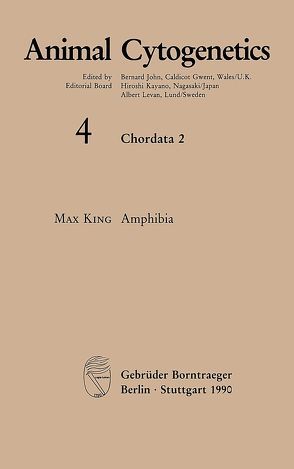
One of the major problems encountered when attempting to provide a comprehensive overview of amphibian cytogenetics is the choice of a suitable taxonomy. Substantial changes to the higher taxonomies continue to occur at a relatively rapid rate, although they have varying levels of acceptance. A comparison of Dowling & Duellman?s (1974) radical reappraisal of the Anura, when compared to the currently aecepted version edited by Frost (1985), shows considerable flexibility at the familial and sub-familial levels, and major discrepancies in taxonomic affiliations at all levels. Much of the variation in higher taxonomic nomenclature appears to have been strongly influenced by geographic criteria. For example, Savage (1973) argued that the Australian hylid frogs should be relegated to a separate famin called the Pelodryadidae, on largely geographic grounds. Although this step has not gained universal acceptance, Frost (1985) did give these animals subfamilial status. Similarly, Dowling & Duellman (1974) argued that the primitive North American frog Ascapbus truei should be given familial status and placed it in the monotypic famin Ascaphidae. However, Frost (1985) included Ascapbus with three endemic New Zealand species in the Leiopelmatidae, a decision which in the past has been most difficult to justify on geographic grounds. In other cases, such as the Arthroleptidae and Hemisiidae, specialized groups of animals have been elevated to familial status from subfamilial rank because they form a unique and morphologically distinctive assemblage. Such reclassifications have been made possible by the significant taxonomic input being made in these taxa. That is, the additional species which had been described provided systematists with a broad perspective on the range of variation within a higher taxa, and they can therefore more precisely define its limits. The magnitude of the taxonomic changes can be seen in the following two examples. Dowling & Duellman (1974) when discussing the largely African Hyperoliidae considered the then known group to be comprised of 14 genera with 63 species. Twelve years later Frost (1985) recognized 14 genera and 219 species. Similarly, the South American poison arrow frogs of the Dendrobatidae comprised three genera and 60 species (sensu Dowling & Duellman, 1974), whereas, Frost (1985) considered four genera and 116 species. In both examples, these substantial changes to the number of species are a product of the increased taxonomic effort in regions where such studies have in the past been neglected, namely Africa and South America.
Aktualisiert: 2022-05-06
> findR *
MEHR ANZEIGEN
Bücher von King, Max
Sie suchen ein Buch oder Publikation vonKing, Max ? Bei Buch findr finden Sie alle Bücher King, Max.
Entdecken Sie neue Bücher oder Klassiker für Sie selbst oder zum Verschenken. Buch findr hat zahlreiche Bücher
von King, Max im Sortiment. Nehmen Sie sich Zeit zum Stöbern und finden Sie das passende Buch oder die
Publiketion für Ihr Lesevergnügen oder Ihr Interessensgebiet. Stöbern Sie durch unser Angebot und finden Sie aus
unserer großen Auswahl das Buch, das Ihnen zusagt. Bei Buch findr finden Sie Romane, Ratgeber, wissenschaftliche und
populärwissenschaftliche Bücher uvm. Bestellen Sie Ihr Buch zu Ihrem Thema einfach online und lassen Sie es sich
bequem nach Hause schicken. Wir wünschen Ihnen schöne und entspannte Lesemomente mit Ihrem Buch
von King, Max .
King, Max - Große Auswahl an Publikationen bei Buch findr
Bei uns finden Sie Bücher aller beliebter Autoren, Neuerscheinungen, Bestseller genauso wie alte Schätze. Bücher
von King, Max die Ihre Fantasie anregen und Bücher, die Sie weiterbilden und Ihnen wissenschaftliche Fakten
vermitteln. Ganz nach Ihrem Geschmack ist das passende Buch für Sie dabei. Finden Sie eine große Auswahl Bücher
verschiedenster Genres, Verlage, Schlagworte Genre bei Buchfindr:
Unser Repertoire umfasst Bücher von
- Kinga Kowalski, Katharina
- Kinga, Endres
- Kinga, Laura
- Kinga, Oworuszko
- Kinga, Tóth
- Kingata, Yves
- Kingcaid, Renée
- Kingcombe, Gavin
- Kingcome, Gavin
- Kingdon, Jonathan
Sie haben viele Möglichkeiten bei Buch findr die passenden Bücher für Ihr Lesevergnügen zu entdecken. Nutzen Sie
unsere Suchfunktionen, um zu stöbern und für Sie interessante Bücher in den unterschiedlichen Genres und Kategorien
zu finden. Neben Büchern von King, Max und Büchern aus verschiedenen Kategorien finden Sie schnell und
einfach auch eine Auflistung thematisch passender Publikationen. Probieren Sie es aus, legen Sie jetzt los! Ihrem
Lesevergnügen steht nichts im Wege. Nutzen Sie die Vorteile Ihre Bücher online zu kaufen und bekommen Sie die
bestellten Bücher schnell und bequem zugestellt. Nehmen Sie sich die Zeit, online die Bücher Ihrer Wahl anzulesen,
Buchempfehlungen und Rezensionen zu studieren, Informationen zu Autoren zu lesen. Viel Spaß beim Lesen wünscht Ihnen
das Team von Buchfindr.
